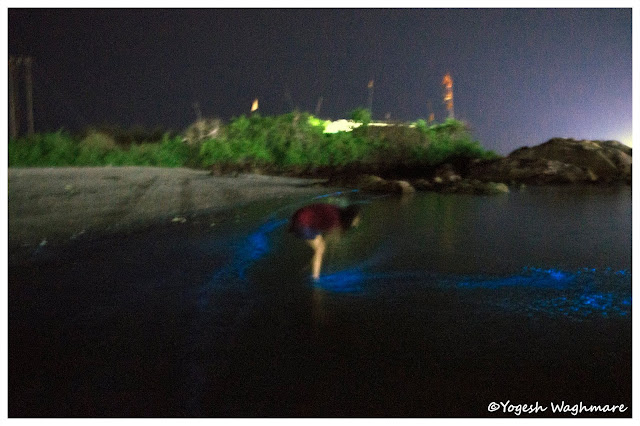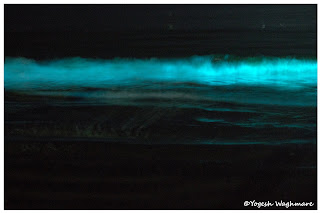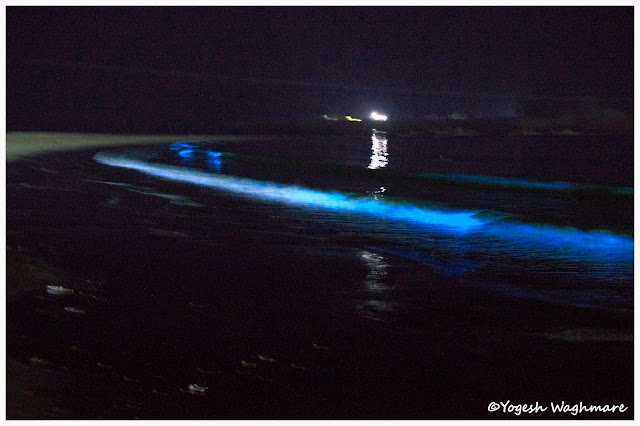



On 27th March 2019 at 12:05 am I came to the beach after my dinner to walk as usual but what I saw at the beach was an unusual thing for me. I saw some glow at waves first I thought it must be a reflection of floodlight but when I observed, the floodlights were white in colour and glow was bluish-greenish in color. For confirmation, I came close to waves and what I saw was like paradise for me. Not just wave currents but whenever I step in water it was glowing and if there was any disturbance in water it starts glowing, it was full greenish-blue glow all over the beach. It was bioluminescence, the first time in life I saw such kind of miracle of nature. Then I called my friends and colleagues at the beach to experience heaven on earth. I know about bioluminescence but I wanted to know more and more about that. I started reading on the internet about that then asking some of my seniors and posting photos of that on social media. When I was searching about this, I didn’t get any record of bioluminescence at Malvan, Maharashtra, India. Local people were saying it comes every year during March-April. So whatever information I got from all the sources, I want to share with you all.
Some of you are familiar with the word ‘Bioluminescence’ but those who don’t know, bio means living organisms and luminescence means emission or production of light just like fluorescent colours or things which glows in darks. Bioluminescence is the emission or production of light by living organisms. It is a form of Chemiluminescence. Chemiluminescence is the emission of light (luminescence), as the result of a chemical reaction.

Bioluminescence occurs widely in marine vertebrates and invertebrates, as well as some fungi, algae, microorganisms and some terrestrial invertebrates such as fireflies. Fireflies are a well-known example of bioluminescence who glows in the night. You might have seen it in many movies, glowing creatures and some plants that might be animated but some of those creatures are real. There are many jellyfishes, fishes, and worms which glow in the deep ocean.

Out of curiosity, I had collected some samples in a bottle and observed under the microscope. Thanks to my friend Munib, he always carries his portable microscope for his work. We observed that the sample and what we got was amazing. Noctiluca scintillans, a dinoflagellate, not technically either animal or plant, was responsible for the glow on the tide of Malvan, Maharashtra. Dinoflagellates are phytoplankton and N. scintillans look like a tiny (0.2 to 2mm) jellyfish. The dinoflagellate eats its food rather than producing it through photosynthesis as a plant would, catching prey with tentacles. N. scintillans glows when it’s disturbed, and this means if it’s attacked or if a boat passes through a group of the dinoflagellate, the ocean will appear to glow. In the case of glowing tides, the disturbance is merely the movement of the water against land and rock. Other dinoflagellates glow as well. The light produced by N. scintillans can be perceived by humans as a ghostly coloured glow or somebody spread blue sparkle on waves, which appears when the water is disturbed. This gives N. scintillans the popular names “sea ghost” or “sea sparkle”.

In this paragraph, I am planning to go under the technical term that how they produce light or glow. As I mentioned that Bioluminescence is a chemiluminescence where light energy released by a chemical reaction. Because of this reaction light-emitting pigments get released, the luciferin, and a luciferase, the enzyme component. In the case of N. scintillans bloom, bloom colour partly derives from the pigments of organisms inside the vacuoles of N. scintillans. Green tides result from N. scintillans populations having green-pigmented prasinophytes, basically green algae which living in their vacuoles.
The ocean can glow and glitter like the stars in the sky, and it was so breathtaking moment of my life. I wanted to know thoughts on this phenomenon from a local fisherman but what I heard from them was shocking. Watching this is a beautiful but local fishermen were saying that I was bad for fishing. Because of glow fishes can able to casted nest and fisherman didn’t get less catch or no catch, so they avoid fishing when bloom comes up. When I searched more about this, then I got some amazing facts. N. scintillans does not appear to be toxic, but it feeds voraciously on phytoplankton, and while doing so, it accumulates and excrete high levels of ammonia into the surrounding water. This may add to neurotoxins produced by other dinoflagellates that kill off other aquatic life in the area.
Bioluminescence on tides may be beautiful and look like heaven on earth but it comes with some price to other life. It is amazing nature my friend…







